FORD E SERIES 1999 4.G 7.3L Diesel Supplement Manual
Manufacturer: FORD, Model Year: 1999, Model line: E SERIES, Model: FORD E SERIES 1999 4.GPages: 39, PDF Size: 0.46 MB
Page 1 of 39
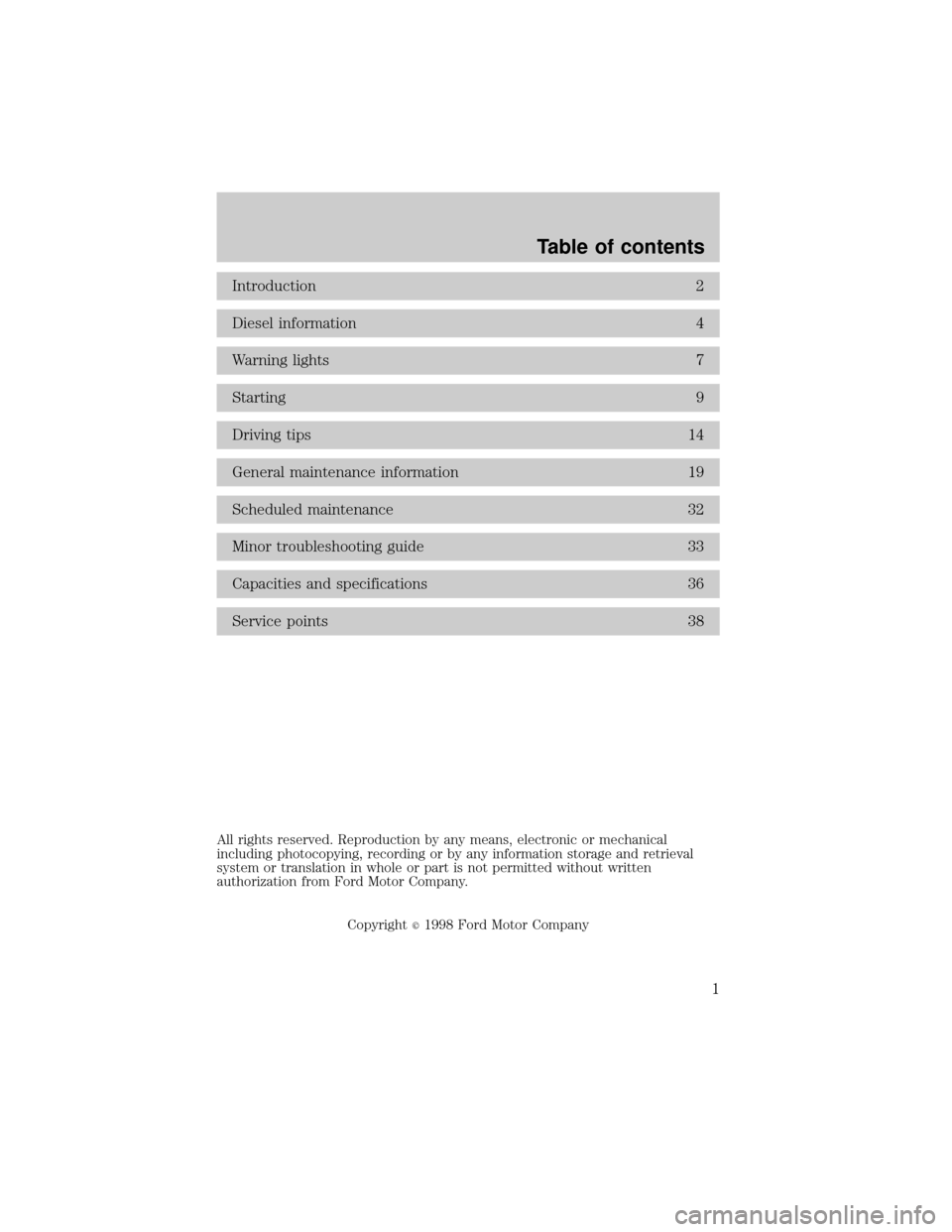
Introduction 2
Diesel information 4
Warning lights 7
Starting 9
Driving tips 14
General maintenance information 19
Scheduled maintenance 32
Minor troubleshooting guide 33
Capacities and specifications 36
Service points 38
All rights reserved. Reproduction by any means, electronic or mechanical
including photocopying, recording or by any information storage and retrieval
system or translation in whole or part is not permitted without written
authorization from Ford Motor Company.
Copyright
r1998 Ford Motor Company
Table of contents
1
Page 2 of 39
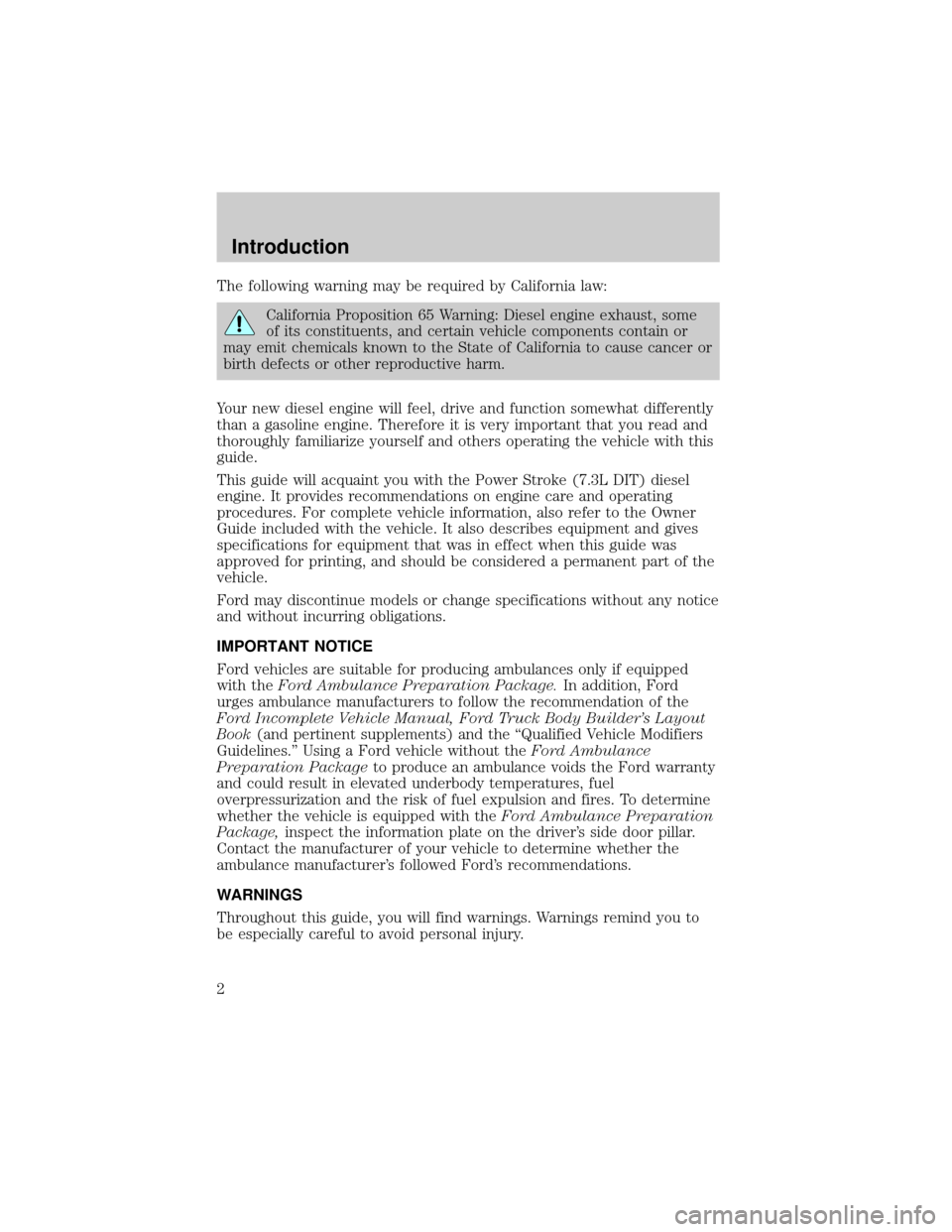
The following warning may be required by California law:
California Proposition 65 Warning: Diesel engine exhaust, some
of its constituents, and certain vehicle components contain or
may emit chemicals known to the State of California to cause cancer or
birth defects or other reproductive harm.
Your new diesel engine will feel, drive and function somewhat differently
than a gasoline engine. Therefore it is very important that you read and
thoroughly familiarize yourself and others operating the vehicle with this
guide.
This guide will acquaint you with the Power Stroke (7.3L DIT) diesel
engine. It provides recommendations on engine care and operating
procedures. For complete vehicle information, also refer to the Owner
Guide included with the vehicle. It also describes equipment and gives
specifications for equipment that was in effect when this guide was
approved for printing, and should be considered a permanent part of the
vehicle.
Ford may discontinue models or change specifications without any notice
and without incurring obligations.
IMPORTANT NOTICE
Ford vehicles are suitable for producing ambulances only if equipped
with theFord Ambulance Preparation Package.In addition, Ford
urges ambulance manufacturers to follow the recommendation of the
Ford Incomplete Vehicle Manual, Ford Truck Body Builder's Layout
Book(and pertinent supplements) and the ªQualified Vehicle Modifiers
Guidelines.º Using a Ford vehicle without theFord Ambulance
Preparation Packageto produce an ambulance voids the Ford warranty
and could result in elevated underbody temperatures, fuel
overpressurization and the risk of fuel expulsion and fires. To determine
whether the vehicle is equipped with theFord Ambulance Preparation
Package,inspect the information plate on the driver's side door pillar.
Contact the manufacturer of your vehicle to determine whether the
ambulance manufacturer's followed Ford's recommendations.
WARNINGS
Throughout this guide, you will find warnings. Warnings remind you to
be especially careful to avoid personal injury.
Introduction
2
Page 3 of 39

NEW VEHICLE BREAK-IN
Your vehicle does not need an extensive break-in. Try not to drive
continuously at the same speed for the first 1 600 km (1 000 miles) of
new vehicle operation. Vary your speed to allow parts to adjust
themselves to other parts.
Drive your new vehicle at least 800 km (500 miles) before towing a
trailer.
Do not add friction modifier compounds or special break-in oils during
the first few thousand kilometers (miles) of operation, since these
additives may prevent piston ring seating. See ªEngine oilº in the
General Maintenance Informationchapter for more information on oil
usage.
Introduction
3
Page 4 of 39

DIESEL ENGINE INFORMATION
The diesel engine fuel system consists of:
²a frame-mounted electric fuel supply pump
²an engine mounted fuel filter/water separator
²a fuel restriction sensor
²a unit injector for each cylinder
The combination fuel filter/water separator removes both water and
impurities from the fuel. The filter should be changed at the
recommended service interval. Refer to the ªService Guideº for more
information. The filter bowl should be drained at regular intervals or
when the ªWATER IN FUELº light illuminates in the instrument cluster.
The fuel injectors are located in the center of the combustion chambers
in the cylinder head between the rocker arm assemblies. The glow plug
system and fuel injection system are controlled through the powertrain
control module (PCM).
Fuel is drawn from the fuel tank by a frame-mounted electric fuel pump.
The fuel pump provides pressurized fuel to the engine and is
electronically controlled by the fuel pump PCM relay. The fuel pump
contains a pressure relief valve for overpressure protection in the event
of restricted flow.
Lubrication system
It is important to change the engine oil at the recommended service
intervals, because oil viscosity is important in maintaining the oil
pressure required to actuate the fuel injectors. Extended oil change
intervals can negatively affect engine performance and fuel economy.
The turbocharger, which is supplied pressurized oil, is also used to
actuate an exhaust backpressure warm-up system (if equipped).
Pressurized oil returning to the turbocharger is routed to the exhaust
backpressure actuator. During exhaust backpressure operation, the
engine's sound will be altered and you may notice a change in engine
performance while it's engaged. This function occurs only during cold
weather warm-up cycle.
Diesel information
4
Page 5 of 39
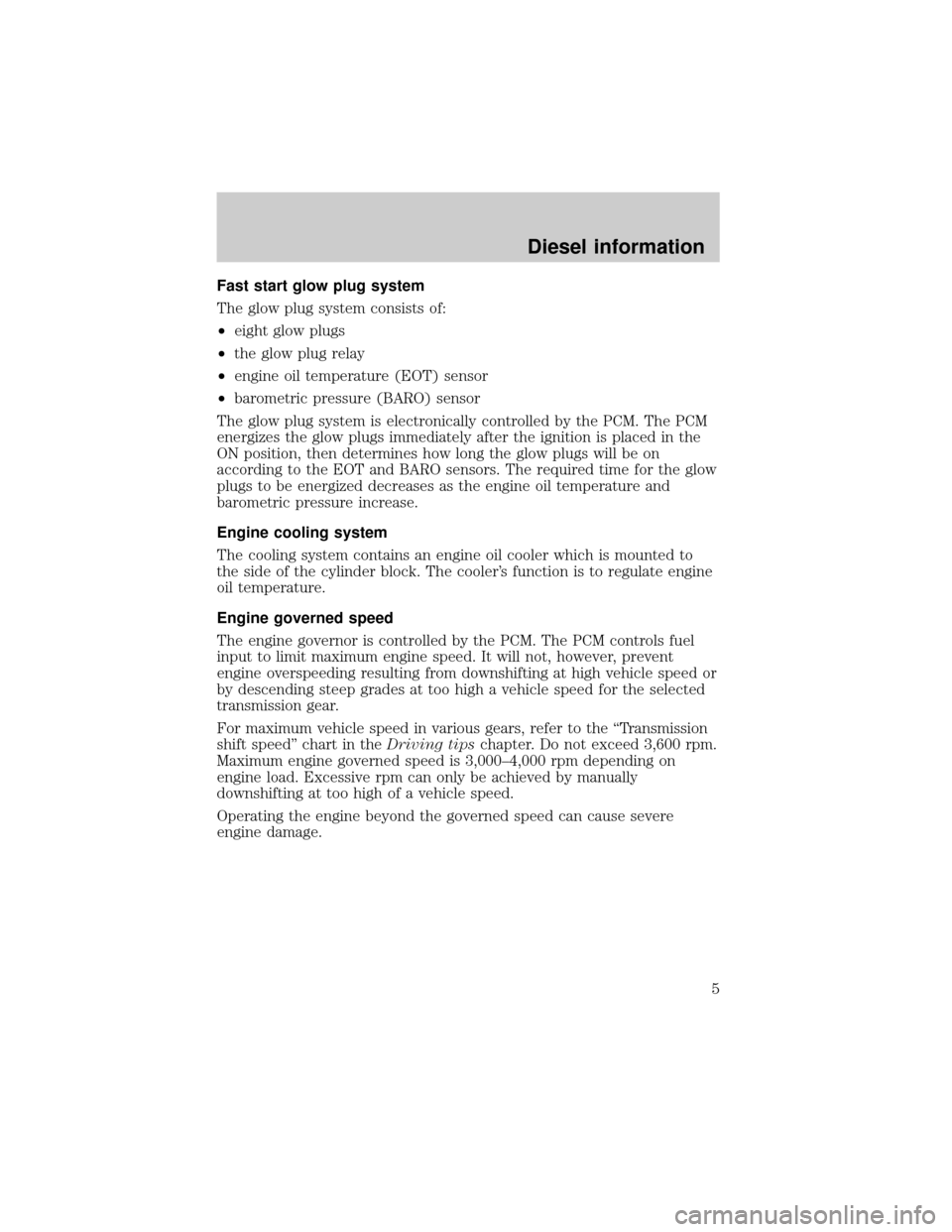
Fast start glow plug system
The glow plug system consists of:
²eight glow plugs
²the glow plug relay
²engine oil temperature (EOT) sensor
²barometric pressure (BARO) sensor
The glow plug system is electronically controlled by the PCM. The PCM
energizes the glow plugs immediately after the ignition is placed in the
ON position, then determines how long the glow plugs will be on
according to the EOT and BARO sensors. The required time for the glow
plugs to be energized decreases as the engine oil temperature and
barometric pressure increase.
Engine cooling system
The cooling system contains an engine oil cooler which is mounted to
the side of the cylinder block. The cooler's function is to regulate engine
oil temperature.
Engine governed speed
The engine governor is controlled by the PCM. The PCM controls fuel
input to limit maximum engine speed. It will not, however, prevent
engine overspeeding resulting from downshifting at high vehicle speed or
by descending steep grades at too high a vehicle speed for the selected
transmission gear.
For maximum vehicle speed in various gears, refer to the ªTransmission
shift speedº chart in theDriving tipschapter. Do not exceed 3,600 rpm.
Maximum engine governed speed is 3,000±4,000 rpm depending on
engine load. Excessive rpm can only be achieved by manually
downshifting at too high of a vehicle speed.
Operating the engine beyond the governed speed can cause severe
engine damage.
Diesel information
5
Page 6 of 39
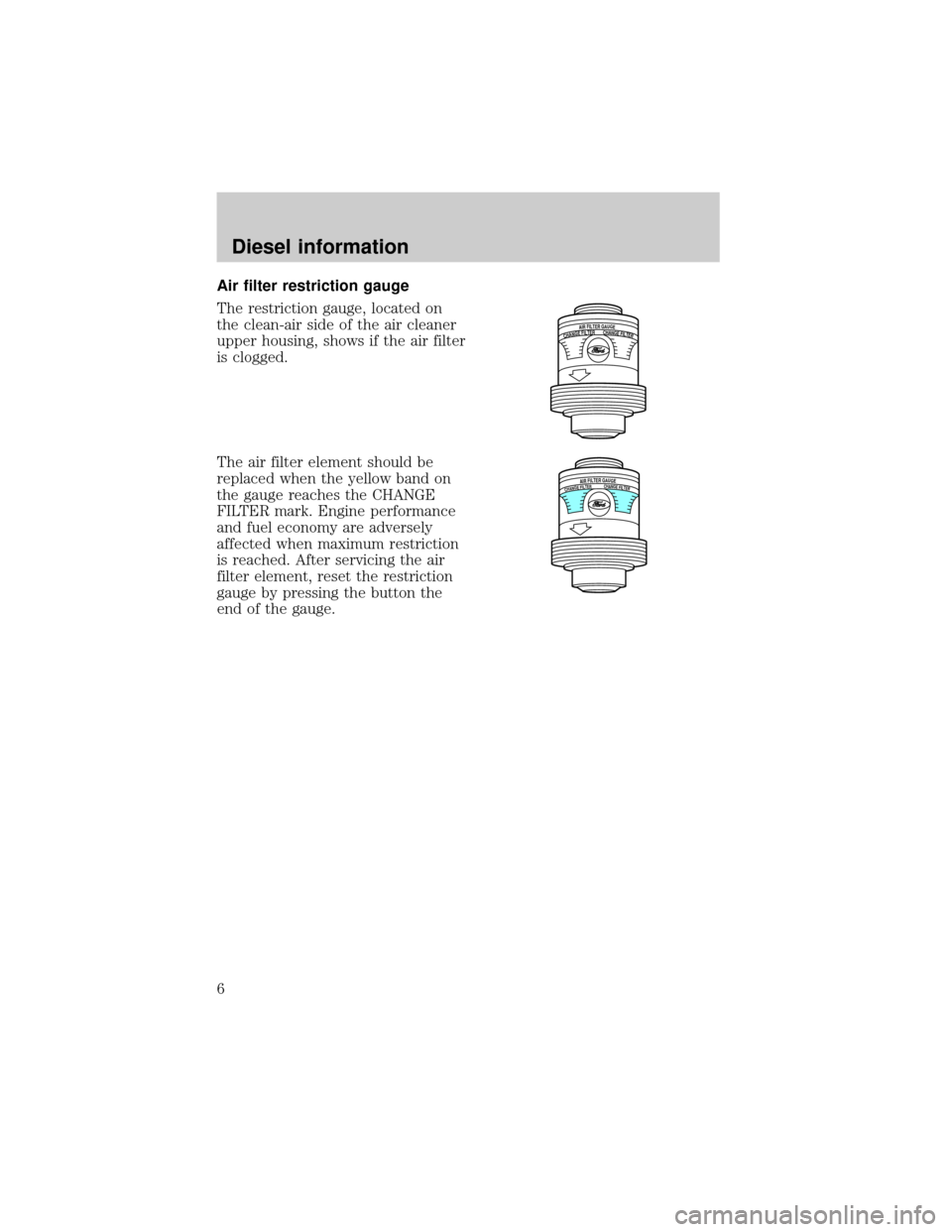
Air filter restriction gauge
The restriction gauge, located on
the clean-air side of the air cleaner
upper housing, shows if the air filter
is clogged.
The air filter element should be
replaced when the yellow band on
the gauge reaches the CHANGE
FILTER mark. Engine performance
and fuel economy are adversely
affected when maximum restriction
is reached. After servicing the air
filter element, reset the restriction
gauge by pressing the button the
end of the gauge.
AIRFILTERGAUGECHANGEFILTERCHANGEFILTER
AIRFILTERGAUGECHANGEFILTERCHANGEFILTER
Diesel information
6
Page 7 of 39
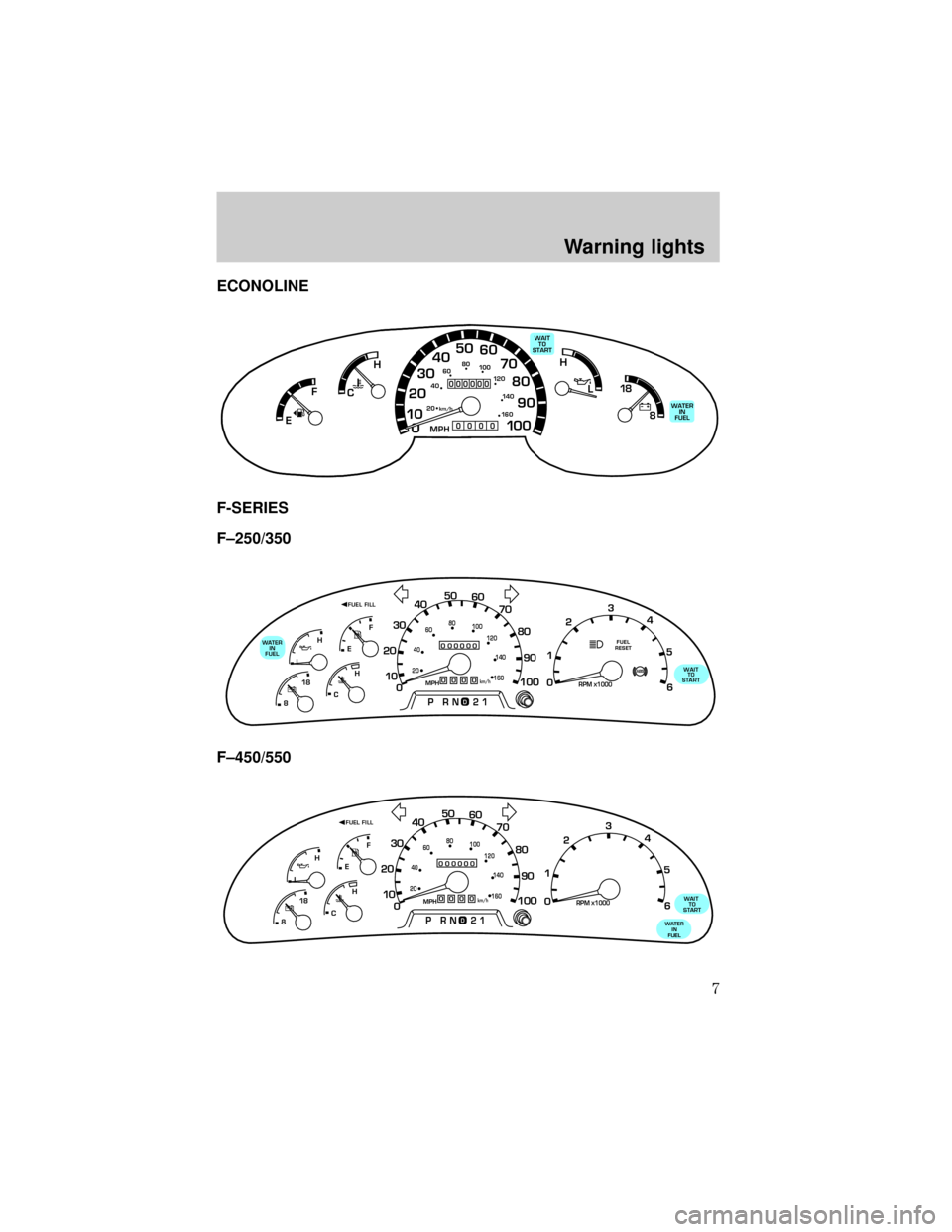
ECONOLINE
F-SERIES
F±250/350
F±450/550
0 1020304050
60
70
80
90
10 0
20 km/h
406080
10 0
12 0
14 0
H
L
16 0
MPH
000000
0000
18
8
WAIT
TO
START
WATER
IN
FUEL
FH
C
E
0
000000000
MPH20km/h
406080
100
120
140
160
010 20304050
60
70
80
90
100
WATER
IN
FUEL
WAIT
TO
STARTFUEL
RESET
ABSLEF
H
RPM1000X0 123
5
6 4
PRN 218C 18
H
D
FUEL FILL
0
000000000
MPH20km/h
406080
100
120
140
160
010 20304050
60
70
80
90
100WAIT
TO
START
WATER
IN
FUEL
LEF
H
RPM1000X0 123
5
6 4
PRN 218C 18
H
D
FUEL FILL
Warning lights
7
Page 8 of 39
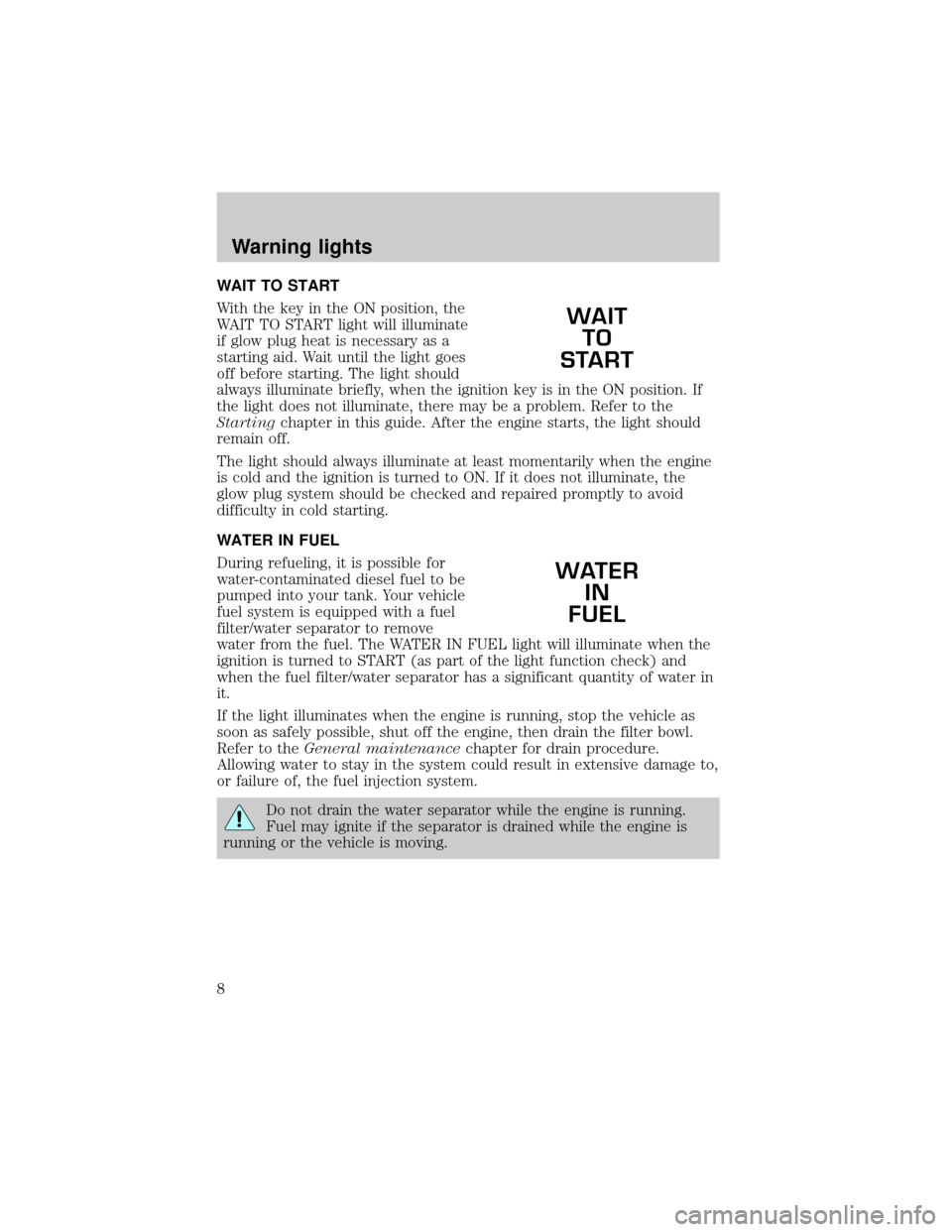
WAIT TO START
With the key in the ON position, the
WAIT TO START light will illuminate
if glow plug heat is necessary as a
starting aid. Wait until the light goes
off before starting. The light should
always illuminate briefly, when the ignition key is in the ON position. If
the light does not illuminate, there may be a problem. Refer to the
Startingchapter in this guide. After the engine starts, the light should
remain off.
The light should always illuminate at least momentarily when the engine
is cold and the ignition is turned to ON. If it does not illuminate, the
glow plug system should be checked and repaired promptly to avoid
difficulty in cold starting.
WATER IN FUEL
During refueling, it is possible for
water-contaminated diesel fuel to be
pumped into your tank. Your vehicle
fuel system is equipped with a fuel
filter/water separator to remove
water from the fuel. The WATER IN FUEL light will illuminate when the
ignition is turned to START (as part of the light function check) and
when the fuel filter/water separator has a significant quantity of water in
it.
If the light illuminates when the engine is running, stop the vehicle as
soon as safely possible, shut off the engine, then drain the filter bowl.
Refer to theGeneral maintenancechapter for drain procedure.
Allowing water to stay in the system could result in extensive damage to,
or failure of, the fuel injection system.
Do not drain the water separator while the engine is running.
Fuel may ignite if the separator is drained while the engine is
running or the vehicle is moving.
WAIT
TO
START
WATER
IN
FUEL
Warning lights
8
Page 9 of 39

STARTING THE ENGINE
Read all starting instructions carefully before you start your vehicle.
Starting procedures are also shown on the vehicle visor. For
temperatures below 0ÉC (32ÉF), the use of the correct grade engine oil is
essential for proper operation.
If your vehicle is equipped with a manual transmission, make sure the
parking brake is set fully before you turn the key. Depress the clutch
pedal and place the gearshift in the neutral position. The clutch must be
fully depressed in order to operate the starter. Do not press the
accelerator during starting.
If your vehicle is equipped with an automatic transmission, ensure the
gearshift lever is in P (Park) and the parking brake is set before you turn
the key. Do not press the accelerator during starting.
COLD WEATHER STARTING
Do not crank the engine for more than 30 seconds at a time as starter
damage may occur. If the engine fails to start, turn the key to OFF and
wait 30 seconds before trying again.
Do not use starting fluid such as ether in the air intake system (see Air
Cleaner Decal). Such fluid could cause immediate explosive damage to
the engine and possible personal injury.
Do not add gasoline, gasohol or alcohol to diesel fuel. This practice
creates a serious fire hazard and causes engine performance problems.
1. Make sure all vehicle occupants have buckled their safety belts. For
more information on safety belts and their proper usage, refer toSeating
and safety restraintschapter in the owner guide.
2. Make sure the headlamps and vehicle accessories are off.
3. Turn the key to the ON position.
When the WAIT TO START light
goes off, turn the key to START.
(For Canadian vehicles, the daytime
running lamps will be on if the
parking brake is not applied and the key is turned to ON.)
4. When the engine starts, release the key. The glow plugs will continue
to be activated for up to two minutes. If the engine is not started before
the activation ceases, the glow plug system must be reset by turning the
ignition key to OFF.
WAIT
TO
START
Starting
9
Page 10 of 39

5. After the engine starts, allow it to idle for about 15 seconds. (Do not
increase engine speed until the oil pressure gauge indicates normal
pressure.)
STOPPING THE ENGINE
Turn the ignition to OFF. To prolong engine life (after extended high
speed or maximum GVW operation), it is recommended that a hot engine
be allowed to operate at low idle for about 7±10 minutes which would
allow sufficient time for the turbocharged engine to cool down.
COLD WEATHER OPERATION
Changing to a lighter grade engine oil also makes starting easier under
these conditions.
At temperatures below ±7ÉC (20ÉF), Number 2±D diesel fuel may thicken
enough to clog the fuel filter. Your engine is equipped with a fuel
filter/heater/water/separator to keep the wax melted which will help
prevent fuel filter clogging. However, if the engine starts but stalls after a
short time and will not restart, the fuel filter may be clogged. For best
results in cold weather, use Number 1±D diesel fuel or ªwinterizedº
Number 2±D diesel fuel which has an additive to minimize wax
formation.
Your vehicle is also equipped with a bypass relief valve, located on the
in-tank fuel sending unit, which provides fuel flow to the engine if the
fuel pickup should become plugged by ice or wax. To allow this bypass
valve to function and avoid engine fuel starvation, it is recommended
that, during cold weather operation 0ÉC (32ÉF) or below, the fuel level in
your tank should not be allowed to drop below 1/4 full. This will help
prevent air from entering the fuel system and stalling the engine.
An auxiliary PCM can be purchased through your Ford dealer which, in
conjunction with your vehicle's control software, allows the engine to run
at an increased idle speed for improving cab heat.
Operation in snow
Vehicle operation in heavy snowfall or in dry loose snow that may swirl
around the front of the vehicle may feed excessive amounts of snow into
the air intake system. This could plug the air cleaner with snow and
cause the engine to stall.
Starting
10